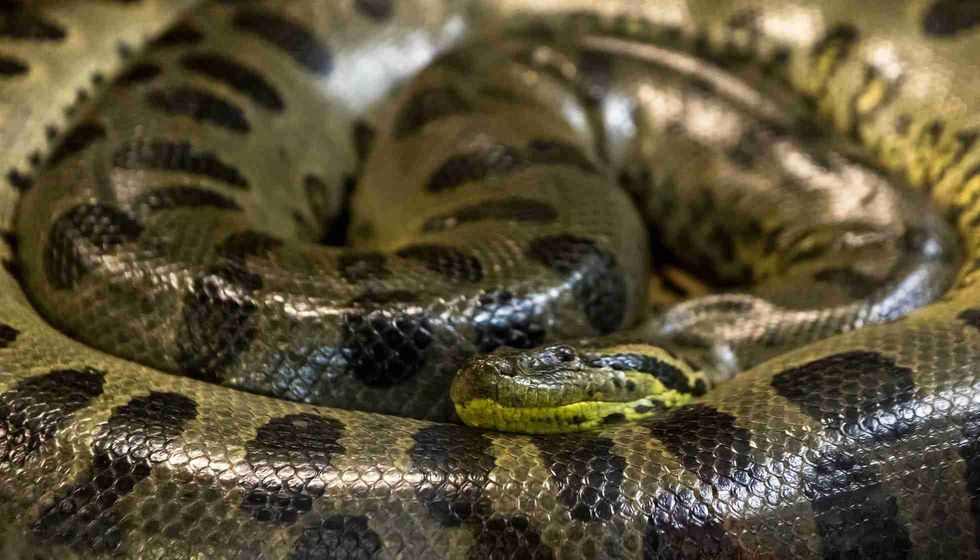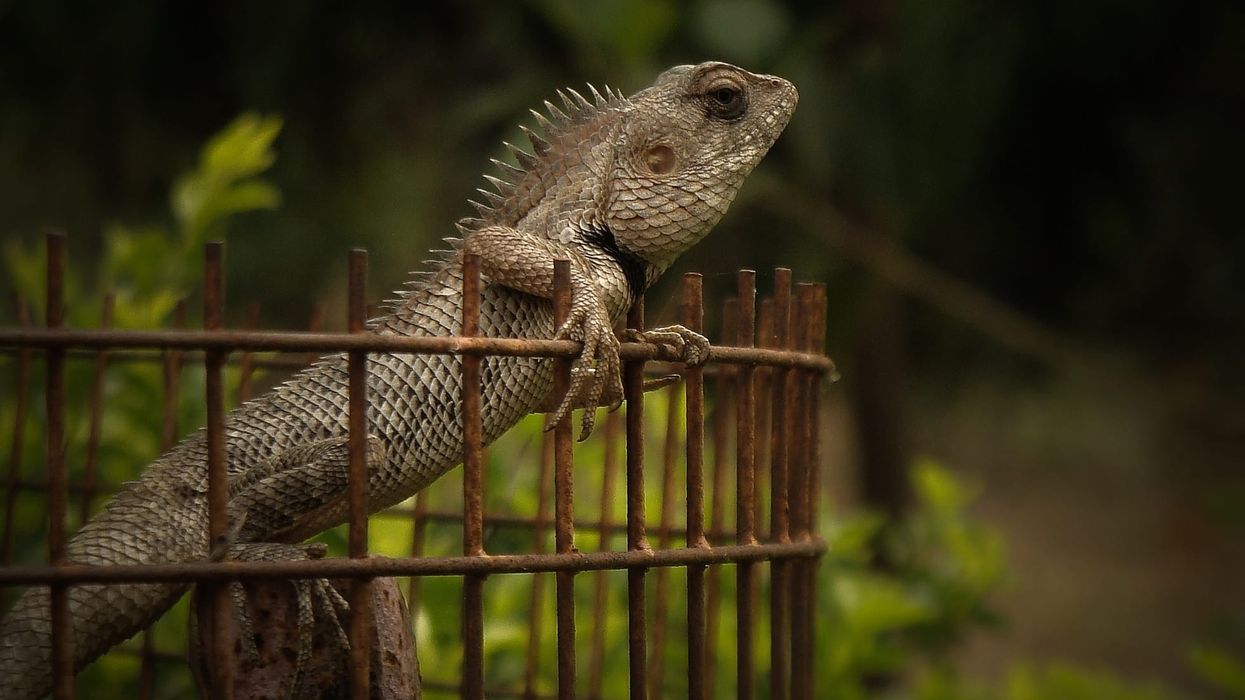The green anaconda is considered to be the world's heaviest snake. Green anacondas are found living in sluggish streams, adjacent swamps, marshes, and rivers of tropical South America.
They are also found in the tropical rainforests of the Amazon and Orinoco basins. A green anaconda is dark to olive green in color and has black spots (oval patches) on its back. It also has black spots that are egg-shaped, moving from the top of their heads to their bodies' posterior.
They also have spots with yellow centers and their belly scales are black and green in color. A green anaconda can move at a speed of 5 mph (8 kmph) on land and 10 mph (16 kmph) underwater.
Green anacondas (Eunectes murinus) feed on large rodents, wild pigs, tapirs, capybaras, fish, deer, peccaries, turtles, birds, sheep, dogs, and aquatic reptiles. Anacondas are not poisonous, they are known for killing their prey by slow constriction.
They are slow-moving snakes that don't have too much venom in them. The green anaconda communicates using pheromones, which are chemical signals given off by their glands. Green anacondas live alone as anacondas prefer solitary living and have their own territories.
According to the IUCN, the conservation status of green anacondas is the Least Concern, so they are not under threat of becoming extinct or vulnerable.
They are considered to be the heaviest and the largest snake in the world, so why not learn all about them? Here are some interesting green anaconda facts. If you like these animal facts, then do read our guides to the copperhead snake and the olive ridley sea turtle too.
Green Anaconda Interesting Facts
What type of animal is a green anaconda?
The green anaconda belongs to the species of snakes (E.murinus).
What class of animal does a green anaconda belong to?
The green anaconda belongs to the class Reptile.
How many green anacondas are there in the world?
It is difficult to say how many green anacondas there are globally, but we do know that there are four major species of anacondas in the world. The green anaconda, yellow or Paraguayan anaconda, dark-spotted anaconda, and Beni or Bolivian anaconda are the four types.
Where does a green anaconda live?
The green anaconda (Eunectes murinus) is found living in sluggish streams, adjacent swamps, marshes, and rivers of the tropical regions of South America. They are usually found in tropical South America, particularly in the rainforests of the Amazon and Orinoco basins.
What is a green anaconda's habitat?
Green anacondas are mainly found in tropical South America, Trinidad, east of the Andes, southern Bolivia, and north of Paraguay.
Who do green anacondas live with?
Green anacondas live alone. They prefer solitary living and have their own territories.
How long does a green anaconda live?
The average lifespan of green anaconda snakes is 10 years in the wild.
How do they reproduce?
Green anacondas reproduce by forming breeding balls around a single female. These breeding balls of anacondas can last for weeks whilst males wrestle with one another to get a chance to mate.
What is their conservation status?
According to the IUCN, the conservation status of green anaconda snakes is Least Concern. This means that they are not under the threat of becoming extinct or vulnerable.
Green Anaconda Fun Facts
What do green anacondas look like?
A green anaconda is dark to olive green in color and has black spots (or oval patches) on its back. It also has black spots that are egg-shaped, moving from the top of their heads to the back of their bodies.
They also have some spots with yellow centers and their belly scales are black and green in color. Their eyes and nostrils are very sharp too.
How cute are they?
Whether they are cute or not is subjective, and whilst most of us probably don't think of snakes as typically cute animals, some people love them. Due to this very reason, they are sometimes kept as pets by snake lovers!
How do they communicate?
anaconda's
How big is a green anaconda?
A green anaconda is 10 times the size of a rabbit. The typical green anaconda's size varies from 240-360 in (609-914 cm) and an average green anaconda weighs about 550 lb (249 kg).
How fast can a green anaconda move?
The green anaconda is capable of moving with a speed of 5 mph (8 kmph) on land and 10 mph (16 kmph) underwater.
How much does a green anaconda weigh?
A green anaconda weighs about 550 lb (249 kg). It is one of the largest snakes present in the world.
What are their male and female names of the species?
There are no specific male and female names for the largest snake species in the world.
What would you call a baby green anaconda?
A baby anaconda is called a snakelet.
What do they eat?
Green anaconda (Eunectes murinus) feeds on large rodents, wild pigs, tapirs, capybaras, fish, deer, peccaries, turtles, birds, sheep, dogs, and aquatic reptiles.
Are they poisonous?
No, they are not poisonous and they are known for killing their prey by constriction. This species is a slow-moving snake that does not have much venom in it at all.
Would they make a good pet?
No, for the majority of people, they cannot be good pets. Remember that they are adapted to live in sluggish streams, adjacent swamps, marshes, and rivers of South America's tropical regions.
So, keeping in mind the non-availability of these climatic conditions and the general surroundings that serve as an essential part of the green anaconda's adaptations, it is difficult to keep them as pets. Only those with plenty of experience handling snakes and anacondas can keep a green anaconda as a pet.
Did you know...
Green anacondas are considered to be excellent swimmers. They are also the heaviest of all the snakes in the world weighing around 550 lb (249 kg)
The reticulated python is technically the longest snake in the world, but the green anaconda comes close.
Green anacondas can go weeks or even months without eating any food or even drinking water!
Green Anacondas And Humans
Some people do keep these animals as pets and they don't eat humans. However, it is important to know that any prospective anaconda owner needs a lot of experience to own a massive and heavy reptile such as this.
Unique Things About The Green Anaconda
Green anaconda snakes feed on large rodents, wild pigs, tapirs, capybaras, fish, deer, peccaries, turtles, birds, sheep, canines, and aquatic reptiles. This is a huge range of food that they can enjoy!
This is a slow-moving snake that does not have much venom in it, but people worldwide have a misconception that they are poisonous.
Here at Kidadl, we have carefully created lots of interesting family-friendly animal facts for everyone to discover! Learn more about some other reptiles including the sand lizard, or bog turtle.
You can even occupy yourself at home by drawing one on our green anaconda coloring pages.









